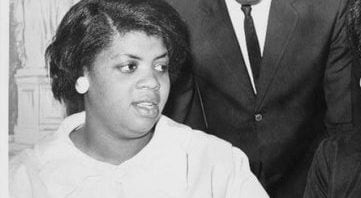
Linda Brown Thompson (Photo: Brown Foundation)
“Linda Brown Thompson is one of that special band of heroic young people who, along with her family, courageously fought to end the ultimate symbol of white supremacy — racial segregation in public schools,” said Sherrilyn Ifill, President and Director-Counsel of NAACP Legal Defense and Educational Fund, Inc. (LDF), on the passing of one of the young students at the heart of Brown v. Board of Education of Topeka, Kansas.
“She stands as an example of how ordinary schoolchildren took center stage in transforming this country,” Ifill said in LDF’s remembrance, adapted here. “It was not easy for her or her family. But her sacrifice broke barriers and changed the meaning of equality in this country. Brown v. Board is the most important, transformational Supreme Court decision of the 20th century.”
Brown Thompson was born on February 20, 1943, in Topeka, Kansas, and died in her hometown on March 25, 2018, at age 75. In 1951, LDF represented Rev. Oliver L. Brown, on behalf of his third-grade daughter Linda, in a lawsuit against the Topeka Board of Education. At the time, McKinley Burnett, president of the local NAACP, was organizing the Topeka case. He successfully enlisted a class of 13 local plaintiffs including Rev. Brown.
Rev. Brown had attempted to enroll his young daughter in the all-white Sumner Elementary School. When the school refused to enroll Linda, she was instructed to attend the under-resourced all-black Monroe School, two miles away from her home. Rev. Brown promised Linda that he would challenge the school’s decision.
LDF represented Rev. Brown and a cadre of 12 families from South Carolina, Delaware, Virginia, and the District of Columbia who had been suffering similar injustices. Their lawsuits were cobsolidated into what is now known as Brown v. Board of Education.
“My father pondered: ‘Why? Why should we have to tell our children that they cannot go to the school in their neighborhood, because their skin is black?’”
— Linda Brown Thompson, 50th anniversary speech at University of Michigan on Jan. 12, 2014
A Decision that Transformed a Nation
In the 1930s, Charles Hamilton Houston of Howard University began masterminding the multi-year legal strategy that led to Brown, and later Thurgood Marshall — Houston’s protégé — executed the legal campaign to end school segregation. Marshall led a legal dream team and a brain trust of cutting-edge researchers to prepare for Brown. The legal team included Jack Greenberg (LDF’s second Director-Counsel and Marshall’s successor), Constance Baker Motley (the first African- American woman appointed as a federal court judge), Robert Carter, Spottswood Robinson II, Oliver Hill, Louis Redding, Charles and John Scott, Harold R. Boulware, James Nabrit Jr., and George E.C. Hayes.
Favorable Supreme Court rulings in a series of civil rights cases litigated by LDF, including Missouri ex rel. Gaines v. Canada, Sipuel v. Oklahoma State Regents, McLaurin v. Oklahoma State Regents, and Sweatt v. Painter — a 1950 case that ruled that “separate and equal” law schools for blacks could not provide a legal education “equal” to that available to white students — secured Brown’s success. These cases along with Justice John Marshall Harlan’s stirring dissent in Plessy v. Ferguson — a shameful precedent from 1896 that upheld the constitutionality of the “separate but equal” doctrine and gave rise to Jim Crow laws across the South — provided the legal foundation LDF attorneys needed to bring down segregation in public elementary and secondary schools throughout the country.
In 1954, the Supreme Court ruled in a unanimous 9-0 decision that “separate but equal” schools violated the Equal Protection Clause of the 14th Amendment. Using modern research by historians and social scientists such as John Hope Franklin and Kenneth and Mamie Clark, LDF’s legal team demonstrated how segregated schools damaged the mental well-being and social development of both black and white schoolchildren. In LDF’s Supreme Court brief, experts warned
In his opinion for the undivided court, Chief Justice Earl Warren zeroed in on the findings aboutbBlack children, writing that, “To separate them from others of similar age and qualifications solely because of their race generates a feeling of inferiority as to their status in the community that may affect their hearts and minds in a way unlikely ever to be undone.”
The Brown ruling overturned the “separate but equal” doctrine, enshrined in Plessy, in our nation’s public schools. The decision also spurred a student movement marked by the student-led sit-ins, bus boycotts, and marches that have become touchstones of the Civil Rights Movement. Legislation from that era and additional court rulings eventually dismantled the legal framework of racial segregation in its entirety.
Linda Brown’s passing is a reminder that our youth have always been our future. Her courage at such a young age to stand up to segregated schools forever changed the fight for our civil rights. I am sending my condolences to the Brown family, along with our entire nation. pic.twitter.com/75Nt0Z6hLn
— Kamala Harris (@KamalaHarris) March 27, 2018
Fulfilling Brown’s Promise and Brown Thompson’s Legacy
In a 1985 interview for PBS’ “Eyes on the Prize” documentary, Brown Thompson said of the pivotal decision, “I really think of it in terms of what it has done for our young people, in taking away that feeling of second class citizenship. I think it has made the dreams, hopes and aspirations of our young people greater, today.”
For the remainder of her life, Brown Thompson steadfastly supported the civil rights cause. After the decision, the Brown family moved in 1959 to Springfield, Missouri. Brown Thompson graduated from Central High School in Springfield and received certification in early childhood education from Kansas State University.
In 1979, Brown Thompson sued the Topeka schools, on behalf of her own children, for not following through with desegregation as mandated by the original Brown case. Federal Judge Richard Rogers ruled in favor of the school district, but an appeals court reversed his ruling. The Supreme Court then declined to review the decision. Judge Rogers approved a desegregation plan for the school district in 1993.
Brown Thompson travelled the country lecturing with family members on the Brown litigation and issues of education inequity. She also served as a Program Associate with The Brown Foundation where she assisted in establishing four libraries for preschool children. The foundation, housed in Brown Thompson’s former grade school, commemorates and advances public discourse about Brown’s impact.
Brown Thompson and her family’s story is a testament to the courage and persistence of many black families and their abiding faith in the possibility of a more just, more equal nation. Their story also demonstrates the risks black families have taken throughout American history to seek justice for all children. The sacrifices of the families represented in Brown advanced America’s path toward equality and continues to fuel the struggle for true equity today.
“The life of every American has been touched by Linda Brown Thompson,” Ifill said. “This country is indebted to her, the Brown family and the many other families involved in the cases that successfully challenged school segregation.








